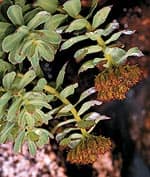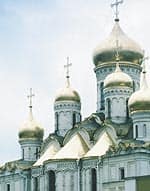Life Extension Magazine®
In November 2004, Life Extension added rhodiola to a multi-nutrient formula that most members use every day. The reason for this addition is that rhodiola has demonstrated a remarkable ability to enhance cellular energy metabolism. As people age, the ability of cells to produce energy is diminished. Scientists have identified cellular energy deficit as the underlying culprit behind most degenerative diseases. The reason coenzyme Q10 has become such a popular supplement among health-conscious adults is its proven ability to maintain and enhance cellular energy production. Because rhodiola remains relatively unknown to Americans, many questions have been asked about its nature and effects. In this article, we provide an overview of the science behind this unique herbal extract. During the Cold War, a strict wall of separation—in politics, culture, science, and other spheres of life—was maintained between the Soviet Union and the United States and other Western nations. In the realm of science, information received by the West was often viewed through a filter that disparaged the accuracy of the data. At the same time, Soviet research was shrouded in a veil of almost obsessive secrecy, lest its potential benefits leak out and reduce any competitive advantage it might convey in the battle against capitalism. With the fall of the Berlin Wall and the eventual breakup of the Soviet Union, the rationale for this separation and secrecy ceased to exist as well. Because of language barriers and lingering prejudices, however, it has taken years for valuable medical research performed in the former Soviet Union to be made available to health-conscious people in Western countries.
One of the casualties of this information roadblock was extensive research performed on rhodiola, an herb that is native to Siberia and northern Scandinavia. Known as “golden root” because of its many therapeutic properties, rhodiola grows in dry, sandy ground at high altitudes in arctic areas of Europe and Asia.1 In traditional folk medicine, the herb, known botanically as Rhodiola rosea, has been used to fight fatigue and depression, increase physical endurance, enhance work productivity, treat impotence, and even prevent altitude sickness. Rhodiola is considered an adaptogen, an agent that increases one’s resistance to biological, chemical, and physical stressors.2 The Soviets studied rhodiola extensively, in part to evaluate its potential benefits for military personnel and athletes participating in international competition. As a result of much promising research, standardized extracts of rhodiola became widely available in the former Soviet Union. Now, thanks to the pioneering efforts of Richard P. Brown, MD, and Patricia L. Gerbarg, MD, coauthors of The Rhodiola Revolution, and Zakir Ramazanov, PhD, coauthor of Arctic Root (Rhodiola Rosea): The Powerful New Ginseng Alternative, Westerners are finally discovering the remarkable benefits of this ancient herbal adaptogen. More Energy for Daily ActivitiesOne of the most frequent complaints of older adults is loss of physical and mental energy. While earlier in life there was plenty of energy to go around, the supply seems to diminish as the years progress. This can be due to many factors. For example, declining hormone levels make it harder to retain muscle and brain tissue that once powered the day’s activities. A more sedentary lifestyle also promotes the loss of lean tissue and a gain of unhealthy body fat. Yet even when controlling for these factors, negative changes that accompany the aging process contribute to energy loss. The human body has three main ways of producing energy. During the first 30 seconds of high-intensity physical activity, energy demand is powered by a pathway known as ATP-CP.3 This involves an exchange of phosphate groups between ATP (adenosine triphosphate) and CP (creatine phosphate) in cellular mitochondria. Energy is produced when ATP is split, leaving a molecule with only two phosphate groups known as ADP (adenosine diphosphate). Creatine phosphate comes to the rescue by donating its phosphate group to ADP, thus re-synthesizing an ATP molecule and allowing it to be used again for energy production. Whenever you pick up a heavy bag of groceries, you are using the ATP-CP pathway.
Unfortunately, the resting level of creatine phosphate declines as we age,4,5 a reduction that contributes to greater fatigue during physical exertion. Compounding this problem is the rate of re-synthesis of creatine phosphate, which declines by up to 9% during each succeeding decade of life after the age of 30.6 For older adults, the good news is that rhodiola has been shown to promote higher levels of ATP and CP, providing more of the energy molecules needed to power many daily activities.7 At the Tomsk State University and Medical Institute in Tomsk, Russia, scientists examined rhodiola’s effects on fighting fatigue and boosting energy.7 Mice with weights attached to them were forced to swim to exhaustion twice a day for six days. Half of the mice received an oral rhodiola extract, while the control group was given only water. By day six, the rhodiola-supplemented group had ATP levels that were 17% higher, and creatine phosphate levels that were 45% higher, than those of the control group. Rhodiola’s benefits did not end there, however. The level of muscle glycogen (a storage form of glucose that can provide energy for more prolonged activities) was 53% greater in the supplemented group than in the control group, while concentrations of muscle lactic acid and ammonia (two toxic byproducts of muscular effort) were 18% and 60% lower, respectively. Clearly, the rhodiola extract helped maintain levels of key energy compounds needed for physical activity, while at the same time decreasing markers of fatigue.7 A recent study at the Russian Academy of Natural Sciences also demonstrated that rhodiola helps boost physical working capacity. In an animal study, an oral rhodiola extract boosted ATP content in the mitochondria of skeletal muscles such that rhodiola-supplemented rats were able to swim 25% longer than control rats before reaching exhaustion.8 This is consistent with research demonstrating that rhodiola helps improve exercise endurance in humans after just a single dose (200 mg of Rhodiola rosea, containing 3% rosavin and 1% salidroside).9 Multiple Benefits of Reduced StressStress is produced whenever an outside stimulus disrupts the body’s normal biological and psychological equilibrium. Over millions of years, the human body has evolved a sophisticated, versatile complex of integrated systems that is able to detect the slightest aberration in this equilibrium. Once detected, these aberrations must be corrected promptly to prevent damage to the body. For most people, stress is a fact of modern life. Today’s world is marked by a frenetic pace of life, mounting financial, occupational, and other pressures, and even social alienation and isolation. These pressures are often exacerbated by factors ranging from unhealthy fast-food diets to environmental pollution. Stress has become unnaturally intensified in ways that undermine our capacity to adapt and remain healthy. This makes stress reduction an essential part of any life extension strategy.
When a stimulus evokes a stress response, the sympathetic nervous system, or sympathetic-adrenal medullary system, is activated.10 This causes the brain to send a message down the spinal cord to the adrenal medulla, signaling it to release a chemical messenger called epinephrine. Epinephrine results in a nonspecific, whole-body stress response. Additionally, a chemical messenger called norepinephrine is released by nerve cells onto particular glands and muscles, contributing to numerous physiological changes that prepare the body for the “fight-or-flight” response. Heart rate and blood pressure increase, while blood volume is diverted away from the skin and to the deep muscles of the legs. Respiratory rate increases and the pupils dilate. Fat and carbohydrate reserves are mobilized to provide energy. All of these responses prime the body to deal with the stressor. So important is it for the body to maintain equilibrium that it also recruits a component of the endo-crine system called the hypothal-amic-pituitary-adrenal axis. This axis is mainly involved in the long-term stress response. The hypothalamic-pituitary-adrenal axis begins in the hypothalamus, a “switching station” in the brain that receives electrical and hormonal impulses from various central, peripheral, and autonomic systems. When the body’s equilibrium is disrupted, the hypothalamus secretes corticotropin-releasing factor, which triggers the release of adrenocorticotropin hormone in the pituitary. Adrenocorticotropin hormone in turn travels to the adrenal cortex, where it stimulates the secretion of a group of compounds called corticosteroids, the most important of which is cortisol. These cortico-steroids promote enhanced carbohydrate metabolism and mineral balance, ensuring an adequate supply of energy and proper fluid balance during the stress response. “While the sympathetic nervous system provides the immediate response to a stressful event—preparing the body to expend energy in a crisis—it is not designed for the kind of prolonged stress we experience today,” notes Richard Brown, MD. “The parasympathetic system counterbalances the sympathetic system, healing and recharging the body. When the stress response system is chronically overstimulated, we tend to feel anxious, irritable, depressed, or fatigued. Rhodiola rosea helps balance the stress response system, reducing anxiety and over-reactivity, enabling people to remain calmer and cope better—whether they have normal or overactive stress response systems. By stabilizing the stress response system, Rhodiola rosea improves physical health and emotional well-being.” Several studies have shown that rhodiola can reduce stress dramatically, thereby increasing mental performance. One such study investigated whether low-dose (170 mg/day) supplementation with rhodiola counters the well-known fatigue and stress experienced by physicians on night duty.11 In this double-blind, crossover study, researchers measured rhodiola’s effect on five different measures of mental acuity: associative thinking, short-term memory, calculation, concentration, and speed of audiovisual perception. They found statistically significant improvements in the 56 young, healthy physicians after just two weeks of supplementation. No side effects were reported.11 Another study explored rhodiola’s benefits during a university examination period.12 In this double-blind trial at Volgograd Medical Academy, 60 foreign students were divided into experimental and placebo groups. The group consuming 100 mg of rhodiola extract a day for 20 days experienced significant improvements in physical work capacity, coordination, and general well-being, along with less mental fatigue and situational anxiety. The ability of these students to learn the Russian language increased by 61% compared to the placebo group, while their relative fatigue levels dropped by 30%. The supplemented students also scored higher on final exams.12
Similar results were observed in a study that measured capacity for mental work within the context of fatigue and stress.13 Scientists at the Centre of Sanitary and Epidemiological Inspection in Moscow gave a single dose of rhodiola to 161 young cadets and measured the results using an anti-fatigue index. They found a highly significant reduction in fatigue from this single dose.13 Rhodiola is beneficial for other forms of stress as well. A study published in Bioscience, Biotechnology and Biochemistry found that rhodiola helped to protect rats from the usual effects of noise-induced stress. Several negative alterations occurred in the livers of the placebo rats when they were subjected to noise levels of greater than 95 decibels, whereas no such alterations were observed in rats that received rhodiola.14 “One of the great things about rhodiola is that it is both calming and stimulating,” notes Dr. Brown. “Usually an herb or drug works only in one direction. Valium, for example, calms your brain but also makes it dull. Rhodiola, in contrast, calms the emotional system and yet is activating and energizing for the brain’s cognitive functions. To have these two benefits at the same time is quite unusual in nature. Rhodiola gets rid of the stress that often interferes with concentration and focus, but leaves your mind sharp and able to perform at its peak. Once people become aware of this herb, it will be very popular.” | |||||
Other Healthful EffectsRhodiola has been shown to have beneficial properties related to brain function, depression, cellular mutation, and heart health. In a rat study using a rhodiola tincture (alcohol-water extract), scientists discovered that a moderate 0.1-ml dose of the herb improved learning and retention after 24 hours.15 With repeated supplementation over a period of 10 days, significant improvements in long-term memory were observed.15 The active constituents in the herb have been found to affect the central nervous system by increasing ability to concentrate and improving cellular resistance to outside influences.16 Rhodiola may play a role in fighting depression. In a group of 128 adult patients with depression and neurasthenia (a condition of fatigue, weakness, and inability to recover by resting), treatment with 150 mg of rhodiola three times a day significantly reduced or eliminated symptoms in 64% of the subjects.17 Among a group of patients hospitalized for depression, the addition of rhodiola to a treatment regimen of tricyclic antidepressants reduced the length of hospital stays and improved the patients’ moods, thought processes, and motor activity.18 Even better, the herb not only reduced troublesome side effects of the antidepressants, but also proved to be effective in treating less severe forms of depression without other medications.
Studies have also demonstrated heart-healthy properties of rhodiola. An eight-day trial of rhodiola extract increased the resistance of experimental animals to drug-induced arrhythmias.19 The researchers believe that this anti-arrhythmic effect is associated with the herb’s induction of opioid peptide biosynthesis. Another study found that rhodiola prevented stress-induced cardiac damage and catecholamine release from the heart muscle.20 These benefits may be partly attributable to rhodiola’s ability to reduce blood levels of both C-reactive protein (CRP), an inflammatory marker, and creatinine kinase, a marker of muscle damage. A study at the Center of Modern Medicine in Russia found a dramatic reduction in these blood markers in rhodiola-supplemented healthy volunteers after stressful exercise.21 If rhodiola is able to reduce CRP induced by other forms of stress—as seems likely—this suggests that the herb can reduce overall levels of inflammation in the body. Given inflammation’s important role in heart disease and many other degenerative conditions, this would be a very important discovery. Further research is needed, however, to confirm these benefits. Several animal experiments suggest that rhodiola has anti-cancer properties. Rhodiola protected the bone marrow cells of mice against mutagenic, drug-induced chromosomal aberrations.22 The herb also inhibited unscheduled DNA synthesis, providing evidence that it can raise the efficiency of cellular DNA repair mechanisms.22 Another experiment on rats with malignant lymphoma found that Rhodiola rosea was as beneficial in inhibiting tumor growth as a partial hepatectomy (removal of the liver) and slightly more effective in preventing metastasis. Further research is needed to determine whether these results extend to humans.23 Recommended Dosage and ContraindicationsConsumers are able to take advantage of rhodiola’s benefits with standardized extracts that provide precise dosages of the active components. This takes much of the guesswork out of selecting a product, as long as you follow a few guidelines. When rhodiola was first being researched, it was believed that the active ingredient is salidroside, a phytochemical found in various plant species. However, further investigation revealed that plants containing only salidroside do not confer the same benefits as rhodiola. Researchers then isolated the plant constituents found only in rhodiola. These critical components include rosavin, rosarin, and rosin, collectively known as rosavins. “We are not sure which chemicals actually do what, but we know that certain chemicals must be present for rhodiola to work,” adds Dr. Brown. “These include rosavin, rosarin, rosin, salidroside, and tyrosol. The last two are found in other plants, but the first three are found only in Rhodiola rosea. It may take a synergistic combination of these chemicals for the herb to work. To ensure that root extracts contain pure Rhodiola rosea, they should be standardized to contain at least 3% rosavins and 1% salidroside, the ratio found in the natural root.”
Herbal Rhodiola rosea supplements should contain a minimum of 3% rosavins and 1% salidroside, matching the concentrations used in clinical trials. This is the rhodiola formulation produced by reputable manufacturers; less ethical companies may try to profit from the herb’s popularity by substituting other members of the rhodiola family. Unfortunately, only Rhodiola rosea has the benefits described in this article. The recommended dosage is 75-150 mg taken twice daily. While the herb has an exceptionally high level of safety, larger doses will not necessarily produce greater results. Active people who stress their bodies physically should aim for the high end of the suggested dosage range; sedentary people will likely require a smaller dose, though one’s level of stress will also be a factor. Because rhodiola can stimulate cognitive processes, it is best taken before breakfast and in the middle of the day. As with most herbs, rhodiola is best taken on an empty stomach. The time required to begin feeling the effects of rhodiola depends on your genetics, mental and physical condition, environment, behavior, and lifestyle.24 Some people begin to feel its effects in just a few days, while others require as much as three weeks. Clinical studies show that most people experience its full benefits in 30-40 days. If you do not notice a change within 40 days, discontinue use, as rhodiola may not be effective for you. Most important, be patient. The negative effects of chronic stress develop over many years, slowly but steadily eroding the body’s balance and often causing fluctuations in mood and energy levels. Recovering one’s balance takes time, so avoid trying to rush the process by megadosing once the first effects are felt. It is better to let the herb take its natural course and slowly restore your body to a more balanced state. A Multifaceted Herbal AdaptogenWith its ability to increase mental energy and physical endurance, rhodiola has tremendous potential to counteract many negative effects of the aging process. Studies show that rhodiola can favorably support the body’s stress reaction, both mentally and physically. In research trials, rhodiola has been shown to boost brain function and have anti-cancer effects. Rhodiola thus provides a safe, effective way to combat many of the conditions faced by older adults, making it a valuable addition to any anti-aging supplement program. | ||
| References | ||
| 1. Saratikov AS, Krasnov EA. Rhodiola rosea is a valuable medicinal plant (Golden root). Tomsk, Russia: Tomsk State University Press; 1987. 2. Brown RP, Gerbarg PL, Ramazanov Z. Rhodiola rosea: a phytomedicinal overview. Herbalgram. 2002;56:40-52. 3. Bowers RW, Fox EL. Sports Physiology. Dubuque, IA: Wm. C. Brown Publishers; 1992. 4. McCully KK, Forciea MA, Hack LM, et al. Muscle metabolism in older subjects using 31P magnetic resonance spectroscopy. Can J Physiol Pharmacol. 1991 May;69(5):576-80. 5. Moller P, Bergstrom J, Furst P, Hellstrom K. Effect of aging on energy-rich phosphagens in human skeletal muscles. Clin Sci (Lond). 1980 Jun;58(6):553-5. 6. McCully K, Posner J. Measuring exercise-induced adaptations and injury with magnetic resonance spectroscopy. Int J Sports Med. 1992 Oct;13 Suppl 1S147-9. 7. Adamchuk LV, Salnik BU. Effect of Rhodiola rosea extract and piridrol on metabolism of rats under high muscular load. Proceedings Institute of Cytology of Russian Academy of Science. 1971;89-92. 8. Abidov M, Crendal F, Grachev S, Seifulla R, Ziegenfuss T. Effect of extracts from Rhodiola rosea and Rhodiola crenulata (Crassulaceae) roots on ATP content in mitochondria of skeletal muscles. Bull Exp Biol Med. 2003 Dec;136(6):585-7. 9. De Bock K, Eijnde BO, Ramaekers M, Hespel P. Acute Rhodiola rosea intake can improve endurance exercise performance. Int J Sport Nutr Exerc Metab. 2004 Jun;14(3):298-307. 10. Brown RP, Gerbarg PL. The Rhodiola Revolution: Transform Your Health with the Herbal Breakthrough of the 21st Century. Emmaus, PA: Rodale Books; 2004. 11. Darbinyan V, Kteyan A, Panossian A, et al. Rhodiola rosea in stress induced fatigue—a double blind cross-over study of a standardized extract SHR-5 with a repeated low-dose regimen on the mental performance of healthy physicians during night duty. Phytomedicine. 2000 Oct;7(5):365-71. 12. Spasov AA, Wikman GK, Mandrikov VB, Mironova IA, Neumoin VV. A double-blind, placebo-controlled pilot study of the stimulating and adaptogenic effect of Rhodiola rosea SHR-5 extract on the fatigue of students caused by stress during an examination period with a repeated low-dose regimen. Phytomedicine. 2000 Apr;7(2):85-9. 13. Shevtsov VA, Zholus BI, Shervarly VI, et al. A randomized trial of two different doses of a SHR-5 Rhodiola rosea extract versus placebo and control of capacity for mental work. Phytomedicine. 2003 Mar;10(2-3):95-105. 14. Zhu BW, Sun YM, Yun X, et al. Reduction of noise-stress-induced physiological damage by radices of Astragali and Rhodiolae: glycogen, lactic acid and cholesterol contents in the liver of the rat. Biosci Biotechnol Biochem. 2003 Sep;67(9):1930-6. 15. Petkov VD, Yonkov D, Mosharoff A, et al. Effects of alcohol aqueous extract from Rhodiola rosea L. roots on learning and memory. Acta Physiol Pharmacol Bulg. 1986;12(1):3-16. 16. Kucinskaite A, Briedis V, Savickas A. Experimental analysis of therapeutic properties of Rhodiola rosea L. and its possible application in medicine. Medicina (Kaunas.). 2004;40(7):614-9. 17. Krasik ED, Morozova ES, Petrova KP, Ragulina GA, Shemetova LA, Shuvaev VP. Therapy of asthenic conditions: clinical perspectives of application of Rhodiola rosea extract (golden root). In: Proceedings of Modern Problems in Psychopharmacology. Kemerovo, Russia: Siberian Branch of the Russian Academy of Sciences; 1970. 18. Brichenko VS, Kupriyanova IE, Skorokhova TF. The use of herbal adaptogens with tricyclic antidepressants in patients with psychogenic depression. In: Modern Problems of Pharmacology and Search for New Medicines. Tomsk, Russia: Tomsk State University Press; 1986. 19. Lishmanov I, Maslova LV, Maslov LN, Dan’shina EN. The anti-arrhythmia effect of Rhodiola rosea and its possible mechanism. Biull Eksp Biol Med. 1993 Aug;116(8):175-6. 20. Maslova LV, Kondrat’ev BI, Maslov LN, Lishmanov I. The cardioprotective and antiadrenergic activity of an extract of Rhodiola rosea in stress. Eksp Klin Farmakol. 1994 Nov;57(6):61-3. 21. Abidov M, Grachev S, Seifulla RD, Ziegenfuss TN. Extract of Rhodiola rosea radix reduces the level of C-reactive protein and creatinine kinase in the blood. Bull Exp Biol Med. 2004 Jul;138(1):63-4. 22. Salikhova RA, Aleksandrova IV, Mazurik VK, et al. Effect of Rhodiola rosea on the yield of mutation alterations and DNA repair in bone marrow cells. Patol Fiziol Eksp Ter. 1997 Oct;(4):22-4. 23. Udintsev SN, Shakhov VP. The role of humoral factors of regenerating liver in the development of experimental tumors and the effect of Rhodiola rosea extract on this process. Neoplasma. 1991;38(3):323-31. 24. Germano C, Ramazanov Z, Del Mar M, Suarez B. Arctic Root (Rhodiola Rosea): The Powerful New Ginseng Alternative. New York, NY: Kensington Publishing; 1999. |







